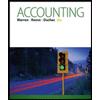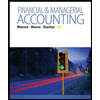Exercise 12-3 Retirement of Bonds Payable on the Statement of Cash Flows-Indirect Method LO3 Redstone Inc. has the following debt outstanding on December 31, 2017: 10% bonds payable, due 12/31/21 Discount on bonds payable $500,000 (40,000) $460,000 On this date, Redstone retired the entire bond issue by paying cash of $510,000. Required 1. Identify and analyze the transaction to record the bond retirement. 2. Describe how the bond retirement would be reported on the statement of cash flows assum- ing that Redstone uses the indirect method.
Exercise 12-3 Retirement of Bonds Payable on the Statement of Cash Flows-Indirect Method LO3 Redstone Inc. has the following debt outstanding on December 31, 2017: 10% bonds payable, due 12/31/21 Discount on bonds payable $500,000 (40,000) $460,000 On this date, Redstone retired the entire bond issue by paying cash of $510,000. Required 1. Identify and analyze the transaction to record the bond retirement. 2. Describe how the bond retirement would be reported on the statement of cash flows assum- ing that Redstone uses the indirect method.
Financial Accounting: The Impact on Decision Makers
10th Edition
ISBN:9781305654174
Author:Gary A. Porter, Curtis L. Norton
Publisher:Gary A. Porter, Curtis L. Norton
Chapter12: The Statement Of Cash Flows
Section: Chapter Questions
Problem 12.3E
Related questions
Question

Transcribed Image Text:Exercise 12-3 Retirement of Bonds Payable on the Statement of Cash
Flows-Indirect Method
LO3
Redstone Inc. has the following debt outstanding on December 31, 2017:
10% bonds payable, due 12/31/21
Discount on bonds payable
$500,000
(40,000)
$460,000
On this date, Redstone retired the entire bond issue by paying cash of $510,000.
Required
1. Identify and analyze the transaction to record the bond retirement.
2. Describe how the bond retirement would be reported on the statement of cash flows assum-
ing that Redstone uses the indirect method.
Expert Solution
This question has been solved!
Explore an expertly crafted, step-by-step solution for a thorough understanding of key concepts.
This is a popular solution!
Trending now
This is a popular solution!
Step by step
Solved in 3 steps with 2 images

Recommended textbooks for you

Financial Accounting: The Impact on Decision Make…
Accounting
ISBN:
9781305654174
Author:
Gary A. Porter, Curtis L. Norton
Publisher:
Cengage Learning

Cornerstones of Financial Accounting
Accounting
ISBN:
9781337690881
Author:
Jay Rich, Jeff Jones
Publisher:
Cengage Learning

Accounting (Text Only)
Accounting
ISBN:
9781285743615
Author:
Carl Warren, James M. Reeve, Jonathan Duchac
Publisher:
Cengage Learning

Financial Accounting: The Impact on Decision Make…
Accounting
ISBN:
9781305654174
Author:
Gary A. Porter, Curtis L. Norton
Publisher:
Cengage Learning

Cornerstones of Financial Accounting
Accounting
ISBN:
9781337690881
Author:
Jay Rich, Jeff Jones
Publisher:
Cengage Learning

Accounting (Text Only)
Accounting
ISBN:
9781285743615
Author:
Carl Warren, James M. Reeve, Jonathan Duchac
Publisher:
Cengage Learning

Financial & Managerial Accounting
Accounting
ISBN:
9781285866307
Author:
Carl Warren, James M. Reeve, Jonathan Duchac
Publisher:
Cengage Learning

College Accounting, Chapters 1-27
Accounting
ISBN:
9781337794756
Author:
HEINTZ, James A.
Publisher:
Cengage Learning,